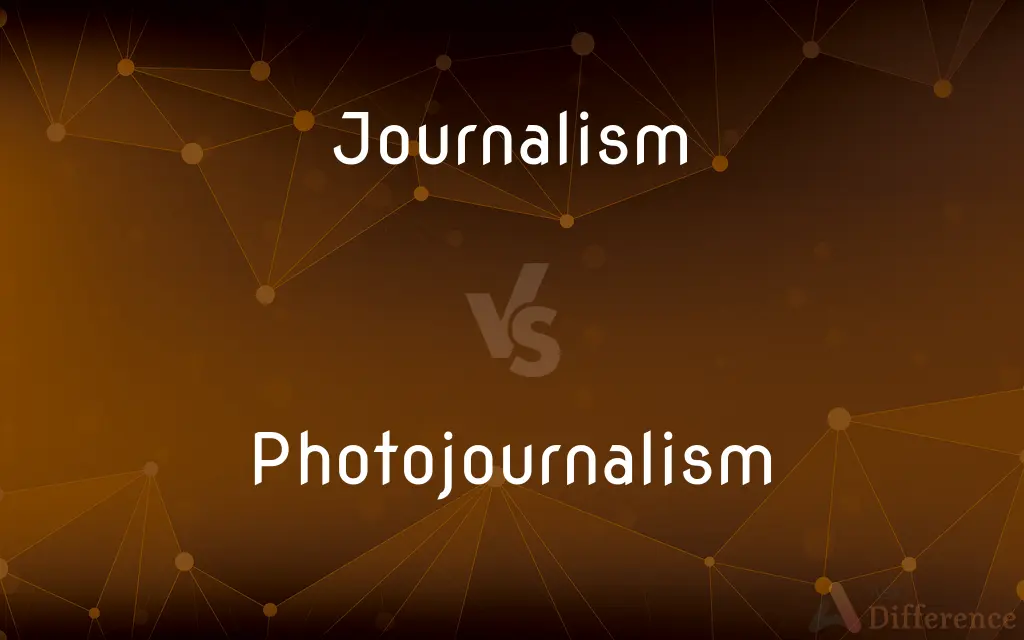Journalism vs. Photojournalism — What's the Difference?
By Urooj Arif & Maham Liaqat — Updated on March 12, 2024
Journalism informs through words, while photojournalism tells stories with images.

Difference Between Journalism and Photojournalism
Table of Contents
ADVERTISEMENT
Key Differences
Journalism encompasses the activity of gathering, assessing, creating, and presenting news and information, primarily through text. It serves to inform, educate, and engage the public on various topics, ranging from politics to entertainment. Photojournalism, on the other hand, is a specific form of journalism that uses photographs to tell a news story, conveying emotions, context, and information visually.
Journalists often rely on written words to narrate stories, providing context, background, analysis, and opinions. They may work for newspapers, magazines, websites, television, or radio. Photojournalists, whereas, capture moments through their lenses, letting the images speak for themselves or complement written stories. Their work is crucial for newspapers, magazines, and increasingly for digital media platforms.
In journalism, the effectiveness of a story can hinge on the quality of writing, the depth of research, and the clarity of the argument or narrative. In contrast, photojournalism relies on the power of a single moment captured in an image, the composition, lighting, and the emotional or informational depth conveyed through visual means.
Journalists often use interviews, research, and analysis to construct their stories, weaving facts into a coherent narrative that provides insight or information. Photojournalists, on the other hand, must be present at the right place and time, possessing an eye for detail, composition, and an understanding of the story they wish to tell visually.
While journalism can cover a wide array of topics including opinion pieces, analyses, and feature stories, photojournalism is typically focused on current events and news stories, aiming to provide a visual documentation that complements or tells a story independently.
ADVERTISEMENT
Comparison Chart
Primary Medium
Text
Photographs
Main Focus
Informing through words
Telling stories through images
Skills Required
Writing, researching, interviewing
Photography, timing, composition
Typical Output
Articles, reports, features
News photos, photo essays, documentary photography
Key Elements
Narrative, context, analysis
Visual impact, emotion, immediacy
Compare with Definitions
Journalism
Reporting of news and events through written text.
Journalists cover stories on various topics, from politics to sports.
Photojournalism
Visual storytelling through photographs in the context of news.
Photojournalists capture impactful images at the scene of events.
Journalism
Can be opinionated, as in editorials or columns.
Columnists provide their perspectives on current events.
Photojournalism
Emphasizes capturing the right moment.
Timing is crucial for a photojournalist waiting for the decisive moment.
Journalism
Involves research, interviews, and analysis.
A journalist may spend weeks researching a complex story.
Photojournalism
Requires knowledge of photographic techniques and equipment.
Effective photojournalism involves understanding lighting, framing, and composition.
Journalism
Aims to inform, educate, and sometimes entertain.
Feature articles in magazines often blend information with entertainment.
Photojournalism
Often conveys emotion and context more immediately than text.
A powerful image can instantly evoke strong emotional responses.
Journalism
Often requires adherence to ethical standards and objectivity.
Ethical journalism involves fair, balanced, and unbiased reporting.
Photojournalism
Bound by ethical standards to represent truth accurately.
Photojournalists strive to maintain the integrity of the scenes they photograph.
Journalism
Journalism is the production and distribution of reports on current events based on facts and supported with proof or evidence. The word journalism applies to the occupation, as well as collaborative media who gather and publish information based on facts and supported with proof or evidence.
Photojournalism
Photojournalism is a particular form of journalism (the collecting, editing, and presenting of news material for publication or broadcast) that employs images in order to tell a news story. It is now usually understood to refer only to still images, but in some cases the term also refers to video used in broadcast journalism.
Journalism
The collecting, writing, editing, and presenting of news or news articles.
Photojournalism
Journalism in which a news story is presented primarily through photographs with supplementary written copy.
Journalism
Material written for publication or broadcast as news
"the anonymous journalism he wrote from Washington" (Garry Wills).
Photojournalism
A form of journalism in which a story is told primarily through photographs and other images
Journalism
The activity or profession of being a journalist.
Photojournalism
Journalism that presents a story primarily through the use of pictures
Journalism
The aggregating, writing, editing, and presenting of news or news articles for widespread distribution, typically in electronic publications and broadcast news media, for the purpose of informing the audience.
Journalism
The style of writing characteristic of material in periodical print publications and broadcast news media, consisting of direct presentation of facts or events with an attempt to minimize analysis or interpretation.
Journalism
The keeping of a journal or diary.
Journalism
The periodical collection and publication of current news; the business of managing, editing, or writing for, journals, newspapers, magazines, broadcasting media such as radio or television, or other news media such as distribution over the internet; as, political journalism; broadcast journalism; print journalism.
Journalism is now truly an estate of the realm.
Journalism
The branch of knowledge that studies phenomena associated with news collection, distribution, and editing; a course of study, especially in institutions of higher learning, that teaches students how to write, edit, or report news.
Journalism
Newspapers and magazines collectively
Journalism
The profession of reporting or photographing or editing news stories for one of the media
Common Curiosities
What is journalism?
Journalism is the activity of gathering, assessing, creating, and presenting news and information through text.
How do journalists convey their stories?
Journalists convey their stories through written words, using interviews, research, and analysis.
What skills are essential for a journalist?
Writing, researching, and interviewing skills are essential for journalists.
Can journalism include photographs?
Yes, journalism can include photographs to complement text, but the primary medium is written words.
How does photojournalism differ from regular photography?
Photojournalism focuses on news and events, aiming to tell stories and convey information through images.
Can journalism be biased?
While journalism strives for objectivity, biases can sometimes appear due to personal or organizational perspectives.
What is photojournalism?
Photojournalism is a form of journalism that tells news stories primarily through photographs.
What are the ethical standards in photojournalism?
Ethical standards in photojournalism include accuracy, fairness, and minimal manipulation of images.
What is crucial for effective photojournalism?
Timing, photographic skill, and an eye for composition are crucial for effective photojournalism.
What makes a good photojournalist?
A good photojournalist has an eye for detail, quick reflexes, and a strong sense of storytelling.
What role do editors play in journalism and photojournalism?
Editors play a crucial role in both fields, selecting, refining, and ensuring the integrity of the content.
Can a photojournalist also write stories?
Yes, some photojournalists also write stories, providing context for their images.
Is photojournalism considered art?
While photojournalism has artistic elements, its primary purpose is to inform and document truthfully.
How do journalists choose topics?
Journalists choose topics based on news value, public interest, and relevance.
How has digital media impacted photojournalism?
Digital media has expanded the reach and immediacy of photojournalism, allowing for rapid dissemination of images.
Share Your Discovery

Previous Comparison
See vs. Sea
Next Comparison
Boy vs. GuyAuthor Spotlight
Written by
Urooj ArifUrooj is a skilled content writer at Ask Difference, known for her exceptional ability to simplify complex topics into engaging and informative content. With a passion for research and a flair for clear, concise writing, she consistently delivers articles that resonate with our diverse audience.
Co-written by
Maham Liaqat














































